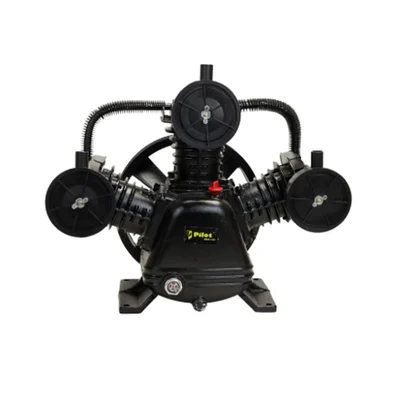- Farm & Garden
- Pumps & Motors
- Food Processing
- Workshop, DIY & MRO

Brand: Pilot
Pilot 65 mm Triple Cylinder 4 HP Belt Driven Air Pump (PL-3065)
SKU: TB-PI-45918 Delivery By: Dec 10 - Dec 12
Delivery By: Dec 10 - Dec 12 




MRP : ₹10980 ₹9999
9% OFF!
 Delivery By: Dec 10 - Dec 12
Delivery By: Dec 10 - Dec 12 
Easy Return
& Refund
& Refund

Quality
Assurance
Assurance

Trusted
Delivery
Delivery

After Sales
Assistance
Assistance

Buyer
Protection
Protection
₹9999 (Including GST)
MRP : ₹10980
9% OFF!
Get Extra ₹150 OFF on Prepaid Orders
Short Description
Pilot 4 HP Belt Driven Air Pump
65 mm Triple Cylinder
Country of origin: India
Specifications
- Brand: Pilot
- Max. Pressure : 8 bar
- Weight (Approx.) : 16 kg
- Tank Capacity : 6 liters
- Model No. : PL-3065
- Power : 4HP
- Max. Pressure : 8 Bar
- Cylinder (mm×piece) : 65 × 2
- Air Displacement : 360 LPM
- Type : Belt Driven
Description
The Pilot Air Pump 3065 is engineered for maximum power and efficiency, making it a prime choice for heavy-duty industrial applications. With its 4HP motor and triple-cylinder setup, this pump delivers superior air output, ideal for professionals who demand high performance and reliability in challenging environments.
Features
:- High Power Capacity : Powered with a robust 4HP motor, delivering dependable performance for even the most demanding applications.
- Impressive Air Pressure : Capable of reaching a maximum of 8 Bar/115 PSI, this pump meets the rigorous requirements of industrial tools and machinery.
- Triple-Cylinder Efficiency : Built with three 65mm cylinders, it achieves exceptional air displacement at 360L/min, ensuring efficient and consistent air delivery.
- Durable Construction : Made with high-quality materials, this pump is designed to endure the stresses of daily industrial use, ensuring long-lasting performance.
- Heavy-Duty Performance : Optimized for continuous use in challenging environments, providing reliable power and efficiency for professionals across various sectors.
Applications
:- Automotive and Repair Shops : Perfect for powering high-demand tools like impact wrenches, sanders, and pneumatic lifts, optimizing productivity in busy workshops.
- Construction and Heavy Equipment : Supplies the strong air pressure needed for equipment like nail guns, jackhammers, and drills, making it invaluable on construction sites.
- Manufacturing and Industrial Operations : Provides reliable air flow for assembly lines, fabrication processes, and other intensive machinery.
Usage
:Usage :
Safety First
- Always read and understand the user manual before operation.
- Wear appropriate safety gear: goggles, gloves, and hearing protection.
- Use the air pump in a well-ventilated, dry area, away from flammable materials.
- Ensure all guards (e.g., belt guard) are in place before starting.
Setup
- Mount the pump securely on a flat, vibration-free surface.
- Ensure the pump is aligned correctly with the motor using the belt drive.
- Check oil level in the crankcase (if oil-lubricated) before starting.
- Verify that all bolts, fittings, and connections are tight and secure.
Starting the Pump
- Connect the pump to a compatible 4HP electric motor with the correct pulley alignment and belt tension.
- Turn ON the motor and allow the pump to build pressure gradually.
- Monitor the pressure gauge if connected to a tank or compressor system.
Operating the Pump
- Ensure the belt tension is optimal during operation to prevent slippage or wear.
- Operate the pump within its rated pressure and duty cycle.
- Avoid continuous operation beyond its designed cycle; allow cooling periods.
- Use with a compatible air tank and regulator for controlled output pressure.
Shutting Down
- Turn off the motor powering the pump.
- Release any residual pressure from the system.
- Disconnect power if performing maintenance or inspection.
Maintenance :
Daily Maintenance
- Check oil level and refill if necessary (use compressor-grade oil like SAE 30).
- Inspect for leaks: air or oil.
- Listen for unusual noises indicating mechanical wear or looseness.
- Drain any moisture from the connected air tank.
Weekly Maintenance
- Clean the air filter: use compressed air to remove dust or replace if heavily soiled.
- Inspect belt condition: look for cracks, frays, or signs of wear.
- Check bolt tightness: especially mounting bolts and pulley fasteners.
Monthly Maintenance
- Inspect pulley alignment and belt tension; adjust if needed.
- Check oil quality and color: if dark, contaminated, or emulsified, replace it.
- Examine the intake and exhaust valves for any blockage or buildup.
Oil Change (Every 3 Months or 100 Hours)
- Warm up the pump for 2–3 minutes to thin the oil.
- Turn off and unplug the power source.
- Remove the oil drain plug and drain oil into a container.
- Refit the plug securely and refill with fresh compressor oil.
- Avoid overfilling - use the sight glass or dipstick to check the correct level.
Annual Maintenance
- Deep clean the pump’s cooling fins to ensure proper heat dissipation.
- Inspect for internal wear, corrosion, or damage (by a technician if needed).
- Replace worn-out belts, gaskets, or filters.
- Have a technician perform a full operational test if used regularly in industrial environments.
Storage Tips
- If not in use for a long time : Drain all oil and moisture, Cover the pump to protect from dust, Store in a dry, cool place away from corrosive materials, Disconnect from the motor or power source.

Select attribute







